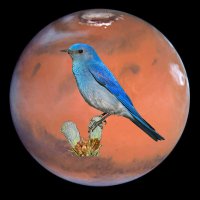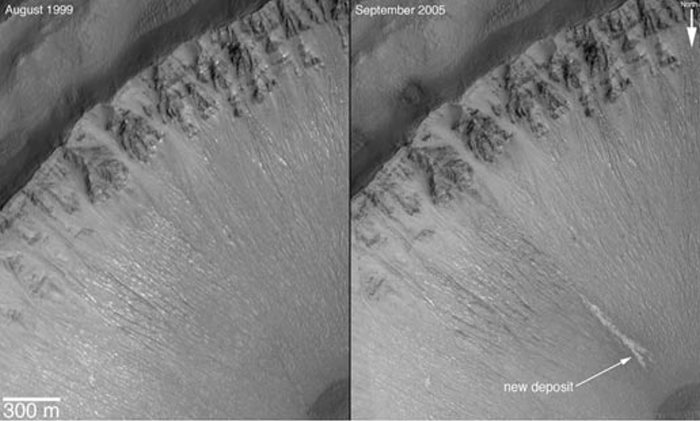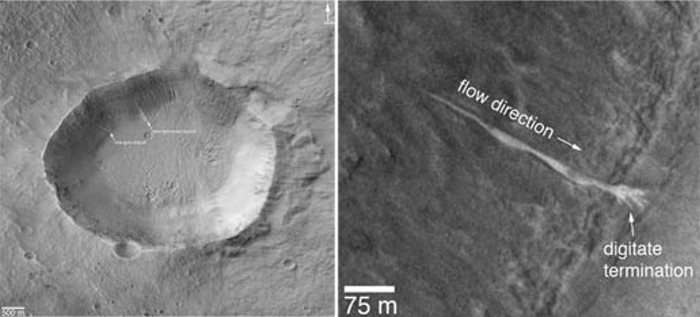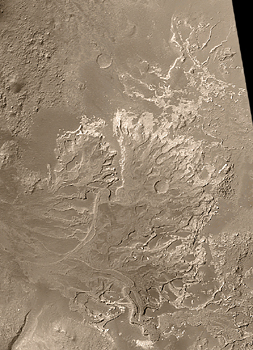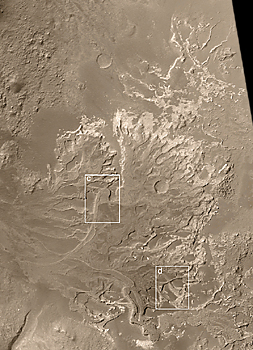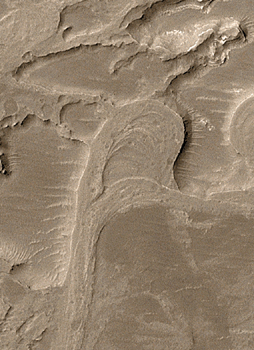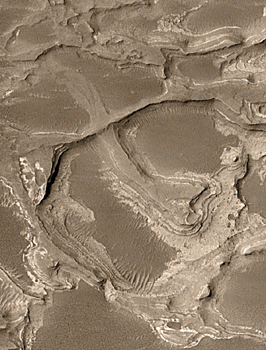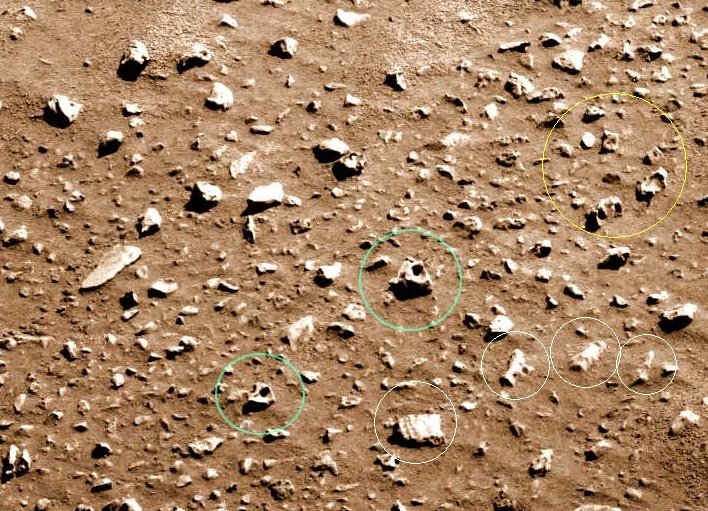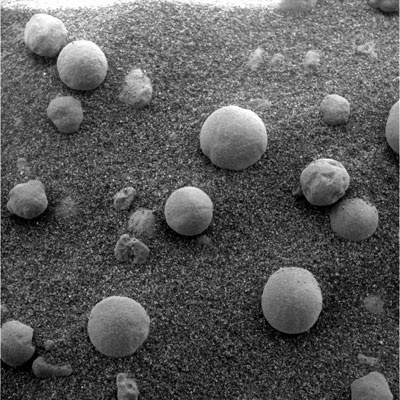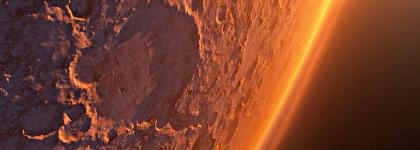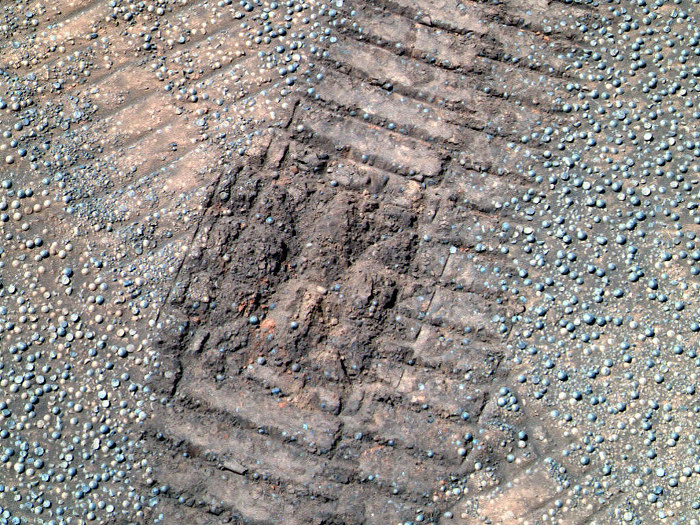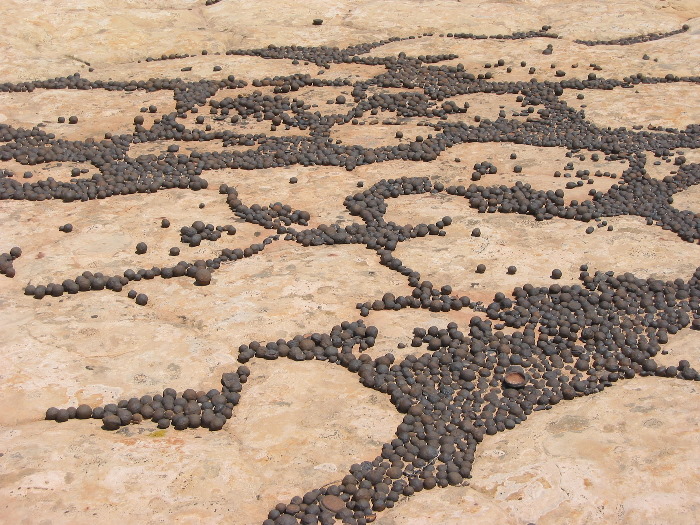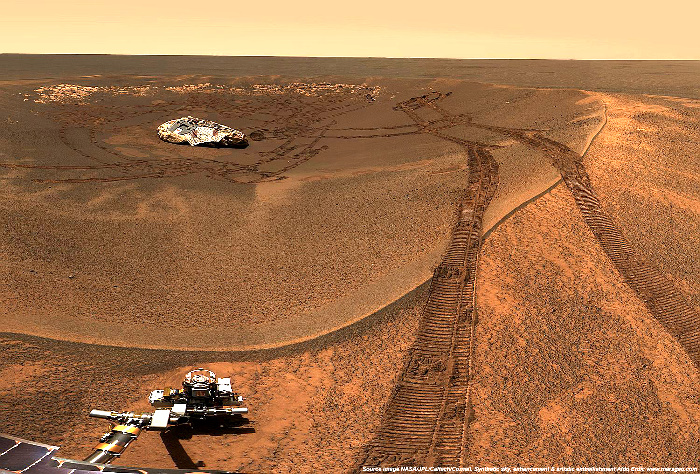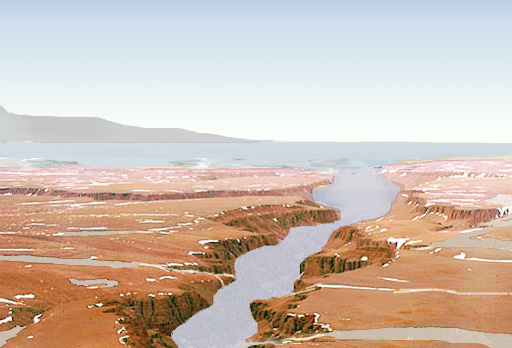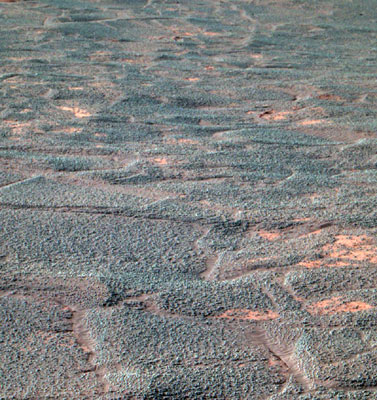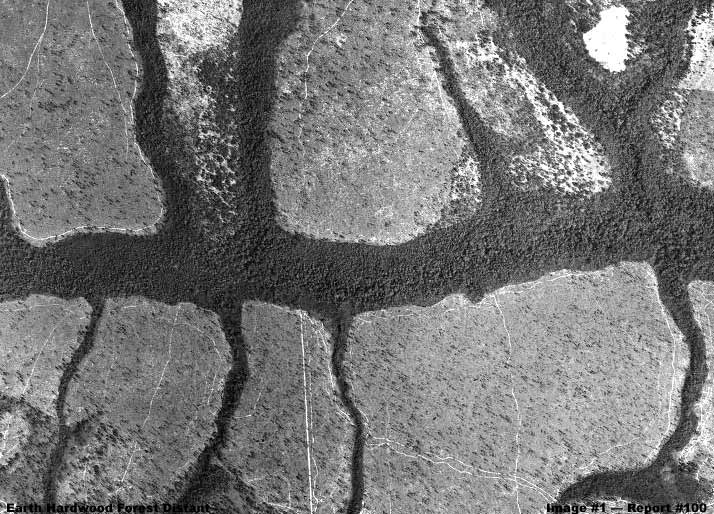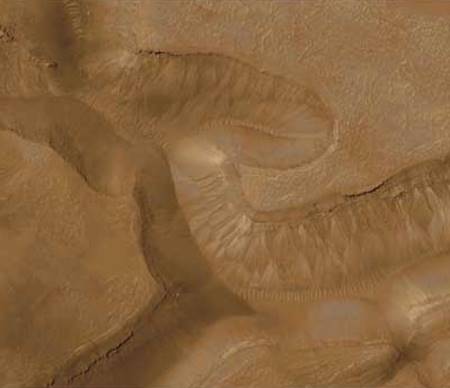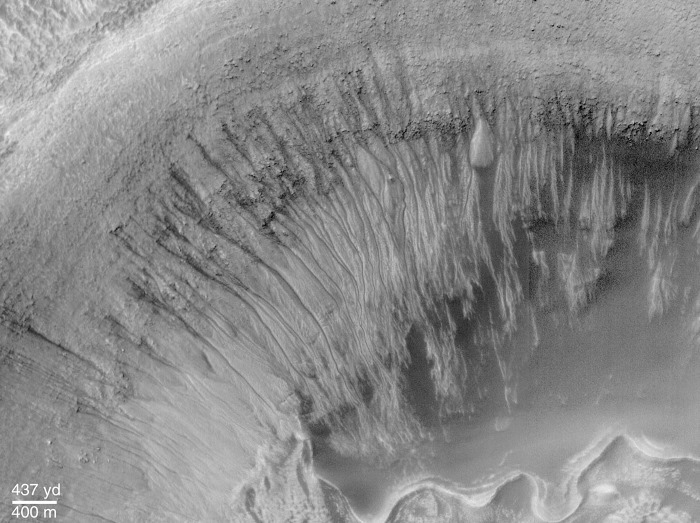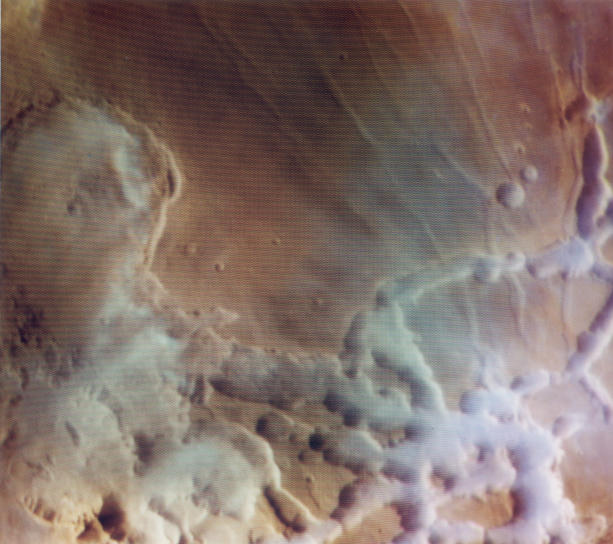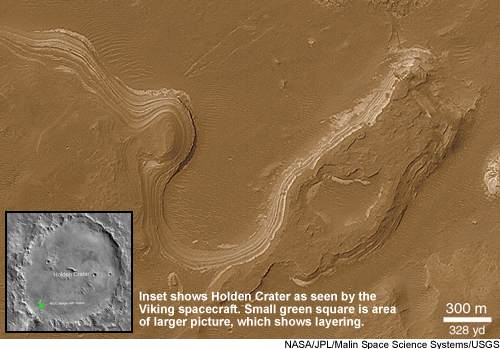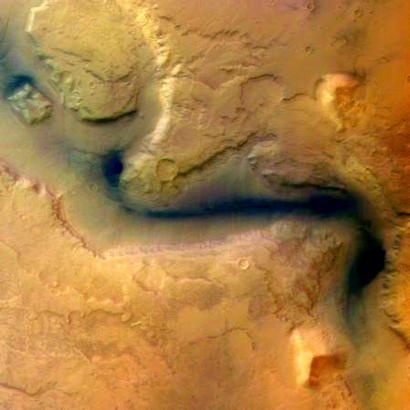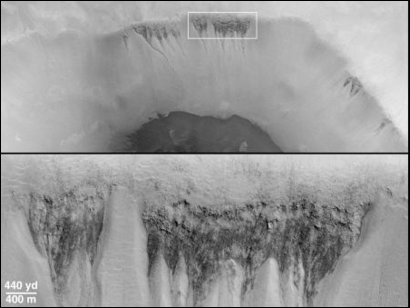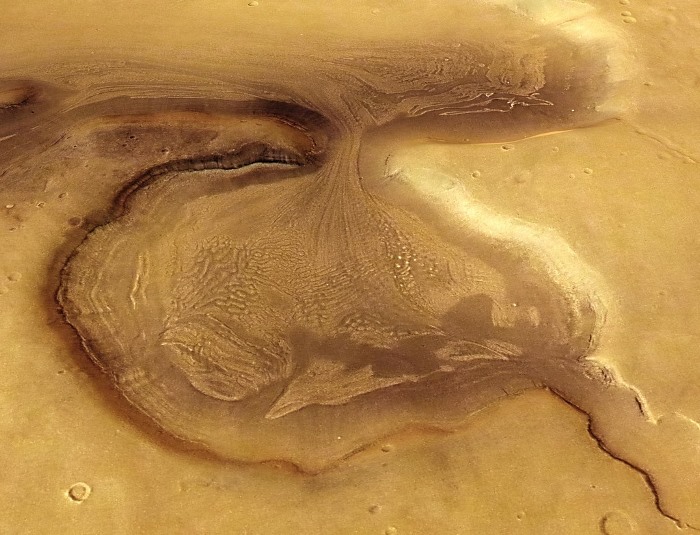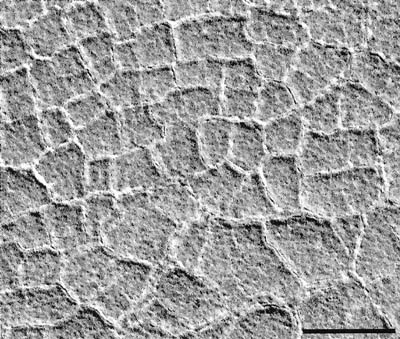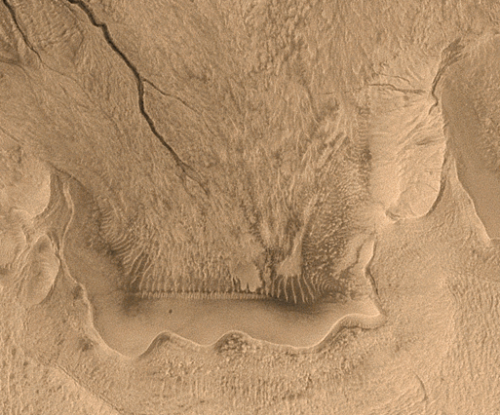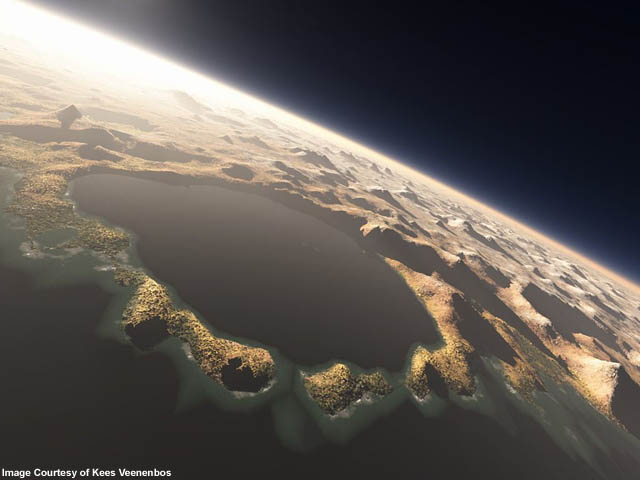|
The Enigmas on Mars |
|||||||||
|
Is There Liquid Water on Mars? Part Four .
The Blue Bird Files
Posted by blue bird, on April 25, 2007 at 05:09 GMT (ID:3142671) quote:
Originally posted by
laiguana
Absolutly and why not! Scanning the Earth scientists found enormous reservoirs of water deep beneath the surface and scientists are saying that the volume of water is at least the Arctic ocean size. Huge ocean Discovered Inside Earth By Ker Than LiveScience Staff Writer
Excerpt “That is exactly what we show here,” Wysession said. “Water inside the rock goes down with the sinking slab and it’s quite cold, but it heats up the deeper it goes, and the rock eventually becomes unstable and loses its water.” The water then rises up into the overlying region, which becomes saturated with watert would still look like solid rock to you,” Wysession told LiveScience. “You would have to put it in the lab to find the water in it.”. SOURCE: Live
Science (On File)
Mars' Missing Air Might Just be Hiding By Ker Than Staff Writer
Excerpt Rather than having had its air knocked out into space, Mars might just be holding its breath. New findings suggests the missing atmosphere of Mars might be locked up in hidden reservoirs on the planet, rather than having been chafed away by billions of years' worth of solar winds as previously thought. Combining two years of observations by the European Space Agency’s Mars Express spacecraft, researchers determined that Mars is currently losing only about 20 grams of air per second into space. Extrapolating this measurement back over 3.5 billion years, they estimate that only a small fraction, 0.2 to 4 millibars, of carbon dioxide and a few centimeters of water could have been lost to solar winds during that timeframe. (A bar is a unit for measuring pressure; Earth’s atmospheric pressure is about 1 bar.) SOURCE: Space.com (On File) |
|||||||||
| Posted by blue bird, on April 25,
2007 at 07:48 GMT
(ID:3142784)
We can look at vast LOWLANDS /north: on average whether Mars had plate tectonics/ on Mars: they are just like Ocean Basins on Earth, without water. Important question: whether Mars had plate tectonics - that shaped this oceans basins and have the ability to reshape ( for exp. sink water beneath)? And water to act like a natural lubricant to keep the sheets of crust in motion. "If one believes early Mars was wet, then it makes plate tectonics more reasonable," says Gerald Schubert of the University of California, Los Angeles. "Alternatively, one could turn this around ? accept plate tectonics, and use this as independent support for a lot of water on early Mars." Terra Sirenium - big highland on southern hemisphere was observed by the Mars Global Surveyor - Surveyor detected buried magnetic fields four times stronger than those it had recorded in the northern region. Plate Tectonics on Mars May 1, 1999
Excerpt One interesting theory, published in 1999 is that these bands could be evidence of the past operation of plate tectonics on Mars, although this has yet to be proven [2]. If true, the processes involved may have helped to sustain an Earth-like atmosphere by transporting carbon rich rocks to the surface, while the presence of a magnetic field would have helped to protect the planet from cosmic radiation. SOURCE: Science News Online (On File) Magnetic Strips Preserve Record of Ancient Mars Excerpt This image is a map of Martian magnetic fields in the southern highlands near the Terra Cimmeria and Terra Sirenum regions, centered around 180 degrees longitude from the equator to the pole. It is where magnetic stripes possibly resulting from crustal movement are most prominent. The bands are oriented approximately east - west and are about 100 miles wide and 600 miles long, although the longest band stretches more than 1200 miles. The false blue and red colors represent invisible magnetic fields in the Martian crust that point in opposite directions. The magnetic fields appear to be organized in bands, with adjacent bands pointing in opposite directions, giving these stripes a striking similarity to patterns seen in the Earth's crust at the mid-oceanic ridges. SOURCE: NASA And again - water!?!? New deposit -
in a time span
of JUST 5 YEARS?
Added by Zorgon... Visit
our page at Pegasus
on New Water Flow Discoveries..
|
|||||||||
| Posted by blue bird, on April 25,
2007 at 09:12 GMT
(ID:3142917)
""Smoking Gun" Evidence for
Persistent Water Flow and
Sediment Deposition on Ancient Mars"
River deltas - lake basins... Distributary Fan: "Smoking Gun" Evidence for Persistent Water Flow MGS MOC Release No. MOC2-543, 13 November 2003 Excerpt What is important about this discovery? First, it provides clear, unequivocal evidence that some valleys on Mars experienced the same type of on-going, or, persistent, flow over long periods of time as rivers do on Earth. Second, because the fan is today a deposit of sedimentary rock, it demonstrates that some sedimentary rocks on Mars were, as has been suspected but never clearly demonstrated, deposited in a liquid (probably water) environment. Third, the general shape, pattern of its channels, and low topographic slopes provide circumstantial evidence that the feature was actually a delta--that is, a deposit made when a river or stream enters a body of water. In other words, the landform discovered by MOC may be the strongest indicator yet that some craters and other depressions on Mars once held lakes. Although hundreds of other locations on Mars where valleys enter craters and basins have been imaged by MOC, this is the first to show landforms like those presented here. SOURCE: Malin Space Systems |
|||||||||
| Posted by blue bird, on April 27,
2007 at 03:24 GMT
(ID:3148020)
"If there is vegetation on Mars, it should be concentrated in the darkarea elements, measuring 10 to 100 kilometers. Vegetation is the best hypothesis to account for seasonal changes in the maria and for the persistence of these formations despite dust storms of global extent. Survival of vegetation in the extreme dryness of the Martian climate could depend on the low night-time temperature and deposition of hoarfrost, which could melt into droplets after sunrise, before evaporating. If not vegetation, it must be something thing specifically Martian; no other hypothesis hitherto proposed is able to account for the facts." *** for Mars lovers: "Mars as the Abode of Life" by Percival Lowell |
|||||||||
| Posted by zorgon, on April 27, 2007
at 03:14 GMT (ID:3148023)
Mars Rovers Explore Hints of Salty Water By Robert Roy Britt Senior Science
Writer
Excerpt NASA's Opportunity rover sent back new images from Mars showing that small spheres previously found on the surface also exist below, in a trench the rover dug. Hints of salty water were also found in the trench, but much more analysis is needed to learn the true composition. Meanwhile Opportunity's twin rover, Spirit, is about to dig a trench of its own in order to investigate soil that sticks to its wheels, suggesting the fine-grained material might be moist. In a press conference today, officials said the soil at both locations could contain small amounts of water mixed with salt in a brine that can exist in liquid form at very low temperatures... Water is the main thing scientists are searching for at Mars, because all life as we know it requires liquid water... SOURCE: Space.com (On File) Sooo seems those rover tracks ARE MUDDY afterall!
|
|||||||||
| Posted by zorgon, on April 27, 2007
at 03:37 GMT (ID:3148025)
Water Once Filled Mars Opportunity Rover Landing Site By Tariq Malik Staff Writer
Excerpt "The landing site of the Mars rover Opportunity was once drenched with water, providing an environment that could have supported life, NASA scientists announced at a press conference today. Water once covered or infused the small crater in which the rover sits, then it gradually evaporated away leaving high concentrations of salt behind. A lake or ocean at the site and beyond might have once been the size of one of Earth's Great Lakes. Or the area might have been loaded with groundwater that rarely if ever reached the surface. And while no signs of biological activity are likely to be uncovered by the current mission, scientists are ecstatic that they now know exactly where to look for past life on Mars..." SOURCE: Space.com (On File) |
|||||||||
| Posted by zorgon, on April 27, 2007
at 03:38 GMT (ID:3148031)
Here is my favorite one... Mars Rover Sits on Ancient Beach 23 March, 2004 Excerpt The US space agency has announced that its robotic Mars rover Opportunity is parked on what was once the shore of a salty Martian sea. There is multiple evidence that the surface of Mars was awash with liquid water at some time in its past. But the latest findings from Nasa's robot explorers on the Red Planet are fleshing out a picture of what Mars must have been like when it was wet... "If you have an interest in searching for fossils on Mars, this is the first place you want to go" Ed Weiler, Nasa - Talking about Opportunity's landing site at Meridiani Planum" SOURCE: BBC News (On File) Why is this my favorite? Well in one of Mike Singh's threads we were discussing fossils... Now here is a NASA Scientist pointing to Rover evidence and telling me WHERE I might find fossils... And for those who haven't seen it
here is the fossil
picture I posted.. (J. Skipper also has this, though
he didn't find as
many specimens :P)
Details and image sources and close
ups of the specimens
can be found here:
|
|||||||||
| Posted by blue bird, on April 27,
2007 at 05:58 GMT
(ID:3148095)
* speaking of “salty“ - here are
some very, very salty
“blueberries“:
*“continuous production of oxygen
atoms and oxygen
molecules“ - the GLOWING in the Martian Night - just
like Earth and Venus
lol:
SOURCE: Astrobiology
Magazine
|
|||||||||
| Mystery
Continues: Scientists
Baffled by Spheres on Mars
By Robert Roy Britt Senior Science
Writer
Excerpt A new close-up image of the Martian surface reveals more of the tiny spherical objects that have been puzzling scientists for several days. Researchers reiterated that they don't know what process created the spheres but that they don't think biology is involved. NASA and journalists had been getting questions from the public about whether the spherules, as they are called, might be fossils. Each spherule is about the size of a
BB. The Opportunity
rover has photographed them on the sandy soil at the
its landing site and
embedded in rocks at a nearby ledge. The new images
include a 3-D view.
The landing site is covered with fine grains of sand, larger irregular-shaped grains that possibly have eroded from the rock ledge, and the "spectacular" spherules, said Mark Lemmon, science team member for the rovers at Texas A&M University. "There's much more than meets the eye in these images," Lemmon said, but he couldn't say what that was. SOURCE: Space.com (On File) Spheres of
Influence:
By Robert Roy Britt Senior Science
Writer
Excerpt Scientists are narrowing the number of explanations for what created tiny spheres of material embedded in a rock outcropping discovered at the landing site of the Mars rover Opportunity. One idea still in the running is that the tiny beads formed in the presence of water. The researchers cannot rule out a volcanic origin, but a thorough examination of the broad outcropping over the next few days could produce a definitive answer. The tiny spherical objects are embedded in layers of a single rock initially nicknamed Snout. It has now been renamed Stone Mountain, though it is actually a small stone -- part of an outcrop of rocks that is only a few inches tall overall. "This is wild looking stuff," said Steven Squyres, principal investigator for the Mars Exploration Rover (MER) project from Cornell University, referring to microscopic images revealing the rocks layers and embedded spherical grains. At a press conference today, Squyres
said the layers
of the rock are made of fine material, probably
either dust or sediment,
and not sandstone. Each layer is just a few
millimeters thick.
The tiny spherules, as they are called, are embedded in the layers "like blueberries in a muffin," he said. The spherules are clearly made of a different material than the rock's primary layers, or matrix, Squyres said. The matrix is tan or buff in color, he said, and the spherules are very gray. "That's a hint that they may be different in composition," he said. SOURCE: Space.com (On File) PEGASUS PAGES on BLUEBERRIES and
their Earth Equivalents...
Click below...
Blueberries on Earth...
|
|||||||||
| Posted by blue bird, on April 27,
2007 at 05:58 GMT
(ID:3148118)
And also - can we trace methane on Mars? On Earth methane is produced by microbes. If we have this nice HARPS instrument ( one that found “Earth-like Gliese 581 c ) and so we know, that spectrometry ( the analysis of light waves) is a very good method - we better hurry to study gases in Mars atmosphere! Excerpt * In 2003, Michael Mumma of Goddard Space Flight Center (GSFC) detected methane using spectrometers at two large earthbound telescopes. He has since told several scientific meetings that large variations exist in methane concentration on Mars. In a presentation at a NASA Astrobiology Institute meeting in April 2005, Mumma said the detection of martian methane varied with geography: there was an average of 200 parts per billion (ppb) detected at the equator, and 20 to 60 ppb near the poles. * Vladimir Krasnopolsky, a research professor at Catholic University of America in Washington D.C., also detected methane on Mars. Like Mumma, Krasnopolsky used spectrometers on Earth-based telescopes. He calculated a global average of 11 ppb, with a range of 7 to 15 ppb. The data, as Krasnopolsky reported to a European Geosciences Union meeting in April 2004, came from 1999 observations of the whole planet's disk. * In December 2004, the European Space Agency's Mars Express delivered the first methane data from a Mars orbiter. In the journal Science, Vittorio Formisano of the Institute of the Physics of Interplanetary Space in Rome and colleagues reported measurements made with the satellite's Planetary Fourier Spectrometer. Their measurements were similar to Krasnopolsky's numbers: A concentration of 10 ppb, plus or minus 5 ppb. SOURCE: Astrobiology Magazine (On File) Methane Bugs Love Ice, so Why Not Mars? Larry O'Hanlon
Excerpt Methane-making microbes inside Greenland ice could be telling us there's life on Mars, say researchers. Newfound microbes trapped in tiny liquid pores deep in glacial ice are raising the possibility that the recently discovered mystery methane in Mars' atmosphere is produced by similar microbes eking out a living in the suspected ample ice buried under the planet's dry surface. SOURCE: News In Science (On File) |
|||||||||
| Posted by blue bird, on April 27,
2007 at 05:36 GMT
(ID:3148118)
quote:
Originally posted by
zorgon
Of course it is muddy! We see it
clearly! We just need
to look at this wet and muddy traces after rover!?
What holds this molecules
together in that composition? If it is also dry dust
- no such footprints
on ground!
Sea on Mars
After Earth, Mars is the planet with the most hospitable climate in the solar system. So hospitable that it may once have harbored primitive, bacteria-like life. Outflow channels and other geologic features provide ample evidence that billions of years ago liquid water flowed on the surface of Mars. Although liquid water may still exist deep below the surface of Mars, currently the temperature is too low and the atmosphere too thin for liquid water to exist at the surface. What caused the change in Mars' climate? Were the conditions necessary for life to originate ever present on Mars? Could there be bacteria in the subsurface alive today? These are the questions that lead us to explore Mars. The climate of Mars has obviously cooled dramatically. By studying the reasons for climate change on Mars, which lacks the complications of oceans, a biosphere, and industrial contaminants, we may begin to understand the forces driving climate change on Earth. As we begin to explore the universe and search for planets in other solar systems, we must first ask the question 'Did life occur on another planet in our own solar system?' and 'What are the minimal conditions necessary for the formation of life?' SOURCE: NASA Mars Polar Lander |
|||||||||
| Posted by blue bird, on April 28,
2007 at 06:04 GMT
(ID:3150769)
* Mars:
|
|||||||||
| Posted by blue bird, on April 29,
2007 at 08:47 GMT
(ID:3153157)
Water!? * Gorgonum Chaos:
* Newton Crater -numerous narrow
channels run from
the top down to the crater floor:
Newton Crater: Evidence for Recent Water on Mars Explanation: What could have formed these unusual channels? Inside a small crater that lies inside large Newton Crater on Mars, numerous narrow channels run from the top down to the crater floor. The above picture covers a region spanning about 3000 meters across. These and other gullies have been found on Mars in recent high-resolution pictures taken by the orbiting Mars Global Surveyor robot spacecraft. Similar channels on Earth are formed by flowing water, but on Mars the temperature is normally too cold and the atmosphere too thin to sustain liquid water. Nevertheless, many scientists now hypothesize that liquid water did burst out here from underground Mars, eroded the gullies, and pooled at the bottom as it froze and evaporated. If so, life-sustaining ice and water might exist even today below the Martian surface -- water that could potentially support a human mission to Mars. Research into this exciting possibility is sure to continue! SOURCE: NASA APOD * Water clouds over Noctis Labyrinthus
Colorful Water Clouds Over Mars Explanation: One place where water can be found on Mars is in clouds. In the above picture colorful water clouds are visible just after sunrise in and around a maze of canyons known as Noctis Labyrinthus (the labyrinth of the night). Scientists don't yet know, however, why these clouds formed, and why some stick to the canyons. One exciting possibility is that water sometimes condenses in shaded regions of the canyons, only to evaporate into clouds when exposed to the morning Sun. Water in any form on the Martian surface might be important to sustaining life and possible future human exploration. Viking Orbiter 1, which visited Mars in 1976, took the above picture. The region shown is about 100 kilometers across. SOURCE: NASA APOD * Holden Crater - lake bed!? - 'The interesting fact is that the traces of lakes are quite widespread. This kind of sedimentation also relates to standing water, it implies that water flowing on Mars was not just sudden outburst of flowing water from under the ground.'
* Water reservoir!?: IMAGE Scientists
confirm water on Mars
Europe's Mars orbiter has detected water molecules vapourizing from the Red Planet's south pole, scientists announced today, calling it the most direct evidence yet of water in the form of ice on the Martian surface. The quest for water on Mars - which could indicate life - has fascinated scientists for centuries. Mars watchers have long believed that the planet's poles contain frozen water, but previous scientific findings - including NASA's Mars Odyssey orbiter's evidence of large amounts of ice - were based more on inferences, European Space Agency scientists said. While Mars Odyssey has been able to indirectly show the presence of water at the pole using temperature monitors, the European camera has for the first time been able to "literally map the polar cap" using infrared technology that shows where water molecules are present, said scientist Jean-Pierre Bibring. Reull Vallis on Hellas basin:
SOURCE: China Daily * Image from the Mars Global
Surveyor, shows evidence
of recent seepage of underground water on a crater
rim:
* Glacial feature - ESA:
This image from the Mars Orbiter Camera clearly shows large contraction-crack polygons which may have developed as a result of the repeated seasonal or episodic melting, freezing and movement of water in an active layer overlying an ice-rich permafrost zone. SOURCE: ESA
|
|||||||||
| Posted by zorgon, on April 29, 2007
at 16:46 GMT (ID:3153947)
quote:
Originally posted
by blue bird
That would be this one... complete with pipes... The Dam
|
|||||||||
| Posted by blue bird, on April 29,
2007 at 20:57 GMT
(ID:3154424)
quote:
Originally posted by
blue bird
quote:
Originally posted by
zorgon
Welcome To Mars Excerpt The hematite in the Martian blueberries is solid evidence that they are, in fact, concretions. This alone would make a strong case for water, but then comes the clincher, the long-awaited spectrometer data from the RAT hole on El Capitan. The instruments say that the rock is as much as 40 percent sulfate salts If you tasted this thing, you'd taste the salt. It's a very, very salt-rich rock. It looks like what geologists call an evaporite deposit. Evaporites form when you have liquid water, with lots of stuff dissolved in it, and the water evaporates away and it leaves stuff behind, so...salt flats. Go to the Great Salt Lake, go to any place where you've evaporated away seawater, and you will find these salt beds. There's an awful lot of sulfate salt in this rock, and that's very, very hard to explain away other than water having been massively involved in creating this stuff. One last piece of evidence would be familiar to anyone who's ever walked on the beach at low tide: ripples created by the flow of water over loose sand. Over long periods of time, rippled sediments can build up and harden into stone. The water is gone, but the ripples are still there in the layered rock at Meridiani. Where the water came from is still unknown, but one possibility is that it came from below as groundwater, laced with sulfuric acid, percolating up through the volcanic bedrock, leaching out elements like iron, creating a broth of dissolved salts. At times the water would flood the surface, forming shallow lakes or seas that would last for a while and then evaporate, leaving a crust of the dissolved sulfate salts behind. This may have happened repeatedly, building up a thick deposit of salty rocks over time. The hematite blueberries would have grown within these rocks while they were saturated with water. Now the water is gone and the rock is eroding away, leaving the harder berries behind. |
|||||||||
|
The Search for Water: Mars
Was a Water
World
Water Discovered: Evidence
for Recent
Water on Mars
Ice Discovered: Huge Ice
Deposits
Cover South Pole
|
|||||||||
|
.
|
|||||||||
| FAIR USE NOTICE: This page contains copyrighted material the use of which has not been specifically authorized by the copyright owner. Pegasus Research Consortium distributes this material without profit to those who have expressed a prior interest in receiving the included information for research and educational purposes. We believe this constitutes a fair use of any such copyrighted material as provided for in 17 U.S.C § 107. If you wish to use copyrighted material from this site for purposes of your own that go beyond fair use, you must obtain permission from the copyright owner. | |||||||||
|
|
